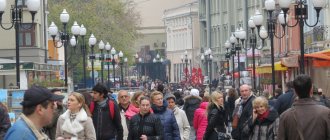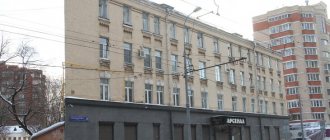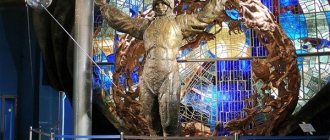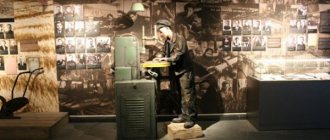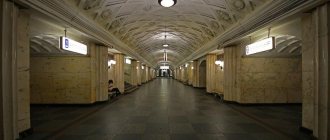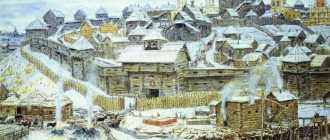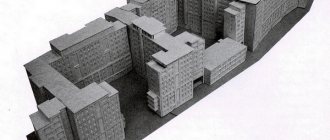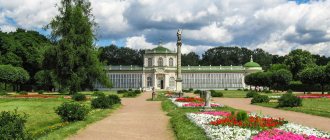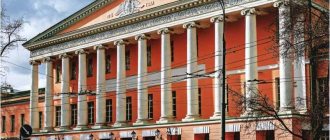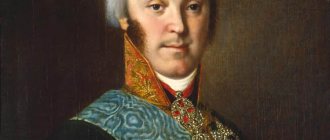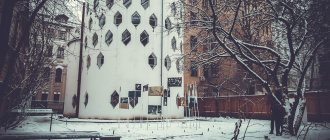History of the Furniture Museum
The building of the Taganka Furniture Museum
Through the efforts of the famous restoration team, the Moscow Furniture Museum was founded in 1999, and the museum received its first visitors on July 17, 2000. To accommodate the exhibition, an architectural monument of the 18th and 19th centuries was completely restored - the city estate of the wealthy landowner N. Ya. Arshenevsky , built in 1813 according to the design of M. F. Kazakov. Looking at the two-story yellow building of an ancient mansion, on which Ionic capitals and pilasters have been preserved from past centuries, it is as if you are returning to the distant past.
Museum "House on the Embankment" on Serafimovicha
The building was built in 1928 in the style of late constructivism by the architect B. Iofan. The House on the Embankment Museum was created here on November 12, 1989, on the initiative of one of the oldest residents, T. Ter-Yeghiazaryan. Since 1997, the building has been a historical monument and is protected by the state.
Since mid-1998, the complex on Serafimovicha was reorganized into the Municipal Museum of Local Lore of the Department of Culture of the Central Administrative District of Moscow. The director was Olga Trifonova, a writer, the widow of the Soviet writer Yuri Trifonov, author of the story “The House on the Embankment.”
Over the course of 20 years, museum staff collected a large amount of material about the history of the house and its inhabitants, including documents, photographs, personal belongings, books and interior items. Thousands of visitors visited the museum.
This is the only House museum in the country and one of the few in the world. Politicians, military leaders, famous artists, writers and scientists lived and still live in it.
Address : Moscow, st. Serafimovicha, 2.
Metro : station “Kropotkinskaya”, “Polyanka”.
Website : https://dnnmuseum.ru
Telephone: +7 495 959–49-36.
Operating mode:
- Tue, Wed, Fri 10:00 – 18:30;
- Thu 11:00 - 21:00;
- Sat, Sun 11:00 – 18:00;
- Monday is a day off.
A small but very educational house-museum. The furnishings of the apartment of the Soviet intelligentsia of the 1930s are recreated here, and authentic furniture created according to the sketches of the chief architect is presented. By the way, this place is part of the Gulag Museum , which impressed me very much.
Museum exposition
The basis of the museum's exhibition was the private collection of antique furniture of the restorer and founder V. V. Smirnov . The collection has been collected since 1972. Priceless furniture rarities, destroyed by time, fell into the hands of talented restorers and were given a second life by skilled craftsmen. Over time, the collection grew so much that it required several rooms.
The museum's exposition occupies 10 halls, where not only antique estate furniture is widely represented, but also works by modern Russian and European masters in different styles - from Baroque to Art Nouveau.
The museum is interesting because the historical interiors of past eras are recreated in the halls. Here you can see what a living room with a fireplace, an office, a boudoir or a bedroom looked like in rich houses of the 18th and 19th centuries. In one of the halls there is an amazing collection of wooden chairs made by serf craftsmen of the 17th century - from a stool to a luxurious antique chair.
And the masterfully carved and painted bureau and card table of the 18th century evoke admiration for the fine jewelry work of the master. The museum also has unique historical items:
- The 19th century chair is the pride of the museum. It was specially made for the coronation of Alexander I in 1801, and according to legend, the hand of the emperor touched it. The chair is made of birch and decorated with a gilded coat of arms.
- The furniture set with swans was made in the 19th century. The tabletop and armrests of the set of chairs are decorated with figures of swans made of black-tinted birch.
- Nun wardrobe , made of pine from the early 19th century, was made as a bet. A landowner, traveling through Europe, saw such a cabinet and bet with his neighbor that his serf would make it even better. The master made a wonderful wardrobe, and the landowner won the argument and gave the serf his freedom.
- Demiurge chair is an example of modern furniture art. The high back of the chair is made in the shape of a man with his arms crossed over his chest. It seems that there is a person behind the one sitting in the chair.
The museum has its own restoration workshops, and if desired, you can order the production of the furniture you like. Here you can also buy books on furniture art. The museum has a restaurant called “Stool” , where restorers and lovers of antique furniture gather.
The uniqueness of the museum lies not only in the fact that it is the only specialized museum of its kind, but also in the fact that here you can touch all the objects with your hands , that is, personally touch the history.
The museum constantly hosts exhibitions of watercolors, which harmoniously fit into ancient interiors. The Furniture Museum also organizes exhibitions of contemporary furniture art and entertainment performances that immerse participants in the world of ancient festive celebrations, such as weddings, matchmaking, name days and other folk festivities.
The Moscow Furniture Museum is a must-visit for anyone who dreams of plunging into the world of another era and learning from a clear example how our ancestors lived . Masterfully executed examples of furniture art can tell a lot about bygone eras.
By the way, about the era... In order to immerse yourself in any period of time, you don’t need to invent a time machine! It is enough to visit the historical museum in Moscow (the one on Red Square) to see with your own eyes ancient objects of one period or another. The majestic setting inside the museum is amazing.
Well, if you unscrew the timeline even later, then you can get to the dinosaurs. In Moscow there is a great opportunity to see the bones of giants in the Paleontological Museum. Yu. Orlova. From this article you will find out whether this museum is suitable for you or not.
House of Scientists on Prechistenka
The building of the House of Scientists was completely rebuilt in the neoclassical style with Art Nouveau elements from the previous building at the end of the 19th - beginning of the 20th centuries by architect Anatoly Gunst for the widow of a major Russian industrialist I. N. Konshin.
The Central House of Scientists was created in 1922 on Prechistenka not by chance - in this area there are many scientific institutes, higher educational institutions, institutes of the Academy of Sciences, the Academy of Arts, humanities faculties of Moscow University, the Russian State Library and a number of museums.
In the House-Museum, long-forgotten but wonderful forms of creative work and good traditions laid down by our predecessors began to be revived. Thanks to the team of employees and the care of the Russian Academy of Sciences, it was possible to preserve the unique spirit of old intelligent Moscow, the spirit of creativity.
Famous theater groups regularly come here on tour, they hold musical and creative meetings with famous writers, scientists, artists, evenings of old romance, and performances by soloists of musical theaters.
Address : Moscow, st. Prechistenka 16.
Metro : station "Kropotkinskaya".
Website : https://www.cdu-art.ru
Telephone: +7 (495) 637–45-55.
Operating mode:
- Monday – Saturday from 12:00 to 22:00;
- Sunday is a day off.
In the building of the Central House-Museum of Scientists there is a large concert hall with 500 seats, a chamber concert hall with 90 seats, a blue living room for meetings and presentations, a Green living room for meetings of scientific sections, as well as a billiard room, a restaurant, a buffet and a cafe.
How to get to the museum
The Furniture Museum is located on Taganskaya Street in house number 13 , building 3. It is very easy to find. First you need to get to the Marksistskaya . When exiting the metro, you need to turn right and, having walked along Marksistskaya Street to Mayakovsky Lane, turn left. Along the alley you need to walk to Taganskaya Street and cross the road to the Furniture Museum.
Next to the museum there is an unusual attraction - “Monument to the first stool of the Russian land” , which was installed in 2000. Its height is about three meters. On the stool you can read an inscription stating that this item has existed in Rus' since the 9th century. Opposite the museum across the road you can admire the beautiful Church of St. Nicholas the Wonderworker on Studenets.
After visiting the furniture museum, it would be a shame not to go to Vysotsky’s house on Taganka. It's not that far (about 11 minutes walk along Taganskaya Street towards the Taganka Theater). Even if you are not a fan of Vladimir Semyonovich’s work, you should still like it there because of the extraordinary atmosphere of the museum.
Pashkov's house on Vozdvizhenka
The legendary Pashkov House, one of the most beautiful architectural monuments in the capital and a universally recognized symbol of Moscow. This majestic building, rising on Vagankovsky Hill, at the intersection of Mokhovaya Street and Znamenka, is known to every Muscovite.
Interesting house museums in Moscow – Pashkov House
The Pashkov House Museum got its name in honor of the first owner, retired officer Pyotr Pashkov. It was by his order that this fabulous mansion was built in the 60s of the 18th century. It is believed that from the belvedere of this building, the heroes of Bulgakov’s novel “The Master and Margarita” Woland and Azazello looked at the city and said goodbye to it, leaving it forever.
Pashkov's mansion on Vozdvizhenka consists of a central building and two wings, which were added later. The main entrance to it is located from Starovagankovsky Lane, and the front facade faces Mokhovaya and faces Borodinsky Hill and the Kremlin.
The building of the house-museum with its porticoes, elegant decorations, columns and skyward belvedere is perceived as a monumental sculpture placed on a kind of pedestal.
Address : Moscow, st. Vozdvizhenka, 3/5, building 1
Metro : station "Borovitskaya", "Library named after. V.I. Lenin", "Alexandrovsky Garden".
Website : https://www.rsl.ru/ru/events/halls/dom-pashkova
Telephone: +7 (499) 557–04-70; +7 (499) 557–04-72.
Operating mode:
- Monday – Saturday from 9:00 to 20:00;
- Sunday is a day off.
In the 18th century, the famous German traveler Richter called Pashkov's house a magical castle. This definition fully corresponds to the appearance of an ancient city estate. The fairy-tale mansion seems light and airy, as if it came from a dream world.
The amazing Pashkov house-museum has been attracting both tourists and Muscovites for almost two centuries. A unique mansion, which has withstood various changes and more than one restoration, has survived many rulers, rises on a hill in the very center of Moscow as a symbol of eternity and beauty that conquers time.
Gogol's House on Nikitsky
The Gogol House-Museum on Nikitsky Boulevard is a 17th-century mansion where the writer spent the last 4 years of his life. This is the only museum of N.V. Gogol in Russia. Cast iron gates lead to the courtyard, where you can linger near the monument to the writer. On the right is an Empire style house with an arcade. To the left of the monument is the “Carriage Barn,” the estate’s utility rooms.
Gogol settled in the house on Nikitsky in 1848 at the invitation of Count A.P. Tolstoy. The exhibition of the Gogol House-Museum on Nikitsky is located in a suite of rooms on the first floor of the main house of the estate.
In each room, the leading object attracts attention. It is turned into a symbolic installation and expresses the accent of the room. In the hallway there is a “chest of wanderings”, in the living room there is a fireplace, in the office there is a desk, in the “Inspector General” hall there is an armchair, in the memory room there is Gogol’s death mask.
Adjacent pieces of furniture and interior details are included in the image at the level of the “supporting” actors. The scientific concept of the museum exhibition was embodied by the artist L. V. Ozernikov. Expanding the museum space through the use of modern technical means allows us to achieve the effect of the presence of Gogol’s characters in the world.
Address : Moscow, Nikitsky Boulevard, 7A.
Metro : station "Arbatskaya", "Alexandrovsky Garden"
Website : https://www.domgogolya.ru
Telephone: +7 495 690–58-81.
Operating mode:
- Mon, Wed, Tue – 12:00–19:00;
- Thu – 14:00–21:00;
- Sat, Sun – 12:00–18:00;
- Tue – day off.
The museum contains authentic historical objects and works of art, as well as things that belonged to Gogol.
In the two rooms on the first floor assigned to him, the writer worked on the second volume of Dead Souls. According to Gogol, the whole of Rus' should have been reflected in the work, where “the entire Russian person would appear with all the variety of wealth and gifts that fell to his lot... and with all the many shortcomings that are in him.”
During the last period of his life in Moscow, the writer was preparing for publication the second collection of his works and working on spiritual prose.

